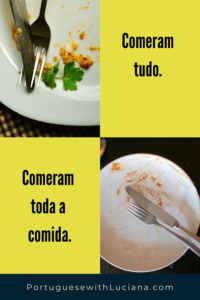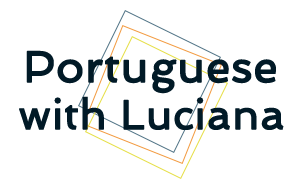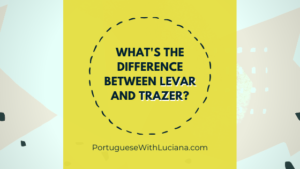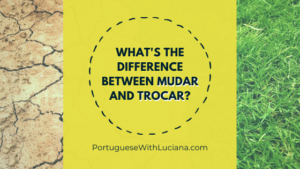Tudo, todo, tuda, tudos, todos… what a mess! These words are almost identical in writing but the use is different, they can’t be used interchangeably!
In this blog post I’ll explain their differences, how to use them, and give examples. If you want, you can also check a video I made about them. At the end of the post, I’ll also include an activity!
So let’s start with…
Tudo
 I think the most important thing to remember is that tudo is invariable. It means there is no other way to write this word. Sometimes students say or write
I think the most important thing to remember is that tudo is invariable. It means there is no other way to write this word. Sometimes students say or write tuda, tudos and they are wrong! Tudo has no feminine or plural forms. Examples:
- Já comi tudo. Agora posso comer a sobremesa? I already ate everything. Can I have the dessert now?
- Ele me contou tudo, não escondeu nada. He told me everything, he didn’t hide anything.
Tudo has a meaning of completeness. In a sentence like “comi tudo” Portuguese speakers don’t need more information in order to understand it (they may want to know what you ate, but that’s another thing), the sentence is complete.
The opposite of tudo is nada. Why is it important to know? If you are in doubt whether you use tudo or todo, try using the word nada in the sentence and see if it makes sense!
If you replace the word tudo with nada in the examples above, you’ll have perfect sentences, too! Check them:
- Já comi tudo. – Não comi nada. I already ate everything. – I didn’t eat anything.
- Ele me contou tudo. – Ele não me contou nada. He told me everything. – He didn’t tell me anything.
Todo – toda – todos – todas
 If you needed to know that tudo is invariable, here you need to know that todo has masculine/feminine and singular/plural forms, as above. Let’s see some examples and compare with tudo:
If you needed to know that tudo is invariable, here you need to know that todo has masculine/feminine and singular/plural forms, as above. Let’s see some examples and compare with tudo:
- Já comi toda a comida. Agora posso comer a sobremesa? I already ate all the food. Can I have the dessert now?
- Ele me contou todos os detalhes, não escondeu nada. He told me all the details, he didn’t hide anything.
Did you notice that when I changed the words to toda or todos I needed to complete the sentence? If you use todo or any of the forms, you need to complete with “what” after todo.
If you say to a Portuguese speaker: Ele bebe todo. The Portuguese speaker will ask you: todo o quê? Because the sentence is not complete! To finish it, you need to say what he drinks: ele bebe todo o leite da mamadeira. And then the sentence is fine for a Portuguese speaker! 🙂
Pronunciation of tudo and todo
Here, you can listen to me reading the examples above. Notice that I don’t pronounce every “o” the same way, sometimes it has an “u” sound.
If you are a beginner in Portuguese, you can stop reading this blog post here and do the activity below. If you are more advanced, then keep reading. (whooo it sounded scary now… hahah)
Todo x todo o x todos os
Yes, there are differences between todo, todo o, todos os (and their feminine forms)! #prontofalei #thereisaidit
Todos os, todas as
The easiest one for you to remember: when you use plural (todos, todas), as a general rule, you’ll need the article (except when you have a numeral after it). So almost always: todos os or todas as. Here, it means cada, qualquer ou a totalidade. Examples:
- Não podemos acreditar em todos os sites da Internet. We can’t believe in all (or every, or each) sites of the Internet.
- Acreditam em todas as besteiras que ele fala. They believe in all (or every, or each) rubbish he says.
- Todas as vítimas do acidente serão indenizadas. All (or every, or each) the victims of the accident will be indemnified.
- Leandro Karnal visitou todos os estados do Brasil a trabalho. Leandro Karnal visited all (or every, or each) states of Brazil for work.
Todo, toda
Now let’s see some examples with todo, toda without an article:
- Toda criança tem direito a uma vida decente. (Each or any) child has the right of a decent life.
- Todo móvel que sai desta fábrica está em perfeito estado. (Each or any) piece of furniture that leaves this factory is in perfect condition.
Todo o, toda a
And the last one todo o, toda a. They have the meaning of totality.
- Leandro Karnal já visitou todo o país (= o país inteiro). Leandro Karnal has visited the whole country.
- Todo o teatro aplaudiu no fim do espetáculo (= o teatro inteiro). The whole theater applauded at the end of the show.
- Toda a viagem foi maravilhosa (= a viagem inteira). The whole trip was wonderful.
As you can see, depending on the use of the article or singular/plural, you have different meanings. Let’s see some more examples:
- Todo o dia = o dia todo = o dia inteiro the whole day
- Todo dia = todos os dias every day
- Eu acordo às 7 todo dia e trabalho o dia todo! I wake up at 7 every day and work all day long!
As a way for you to remember all this information, I’d recommend you to write down some examples of your own and memorize them. Over time, as you use Portuguese, your range of examples will increase.
Activity – tudo ou todo?
Here you have an activity to practice these words.
I hope you got them right and if you have any question, leave me a comment below!



